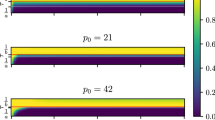Abstract
This article shows that the Gibbs function topological manifold \(G(p,T,x_{1}, x_{2},\ldots ,x_{C})\) at the thermodynamic equilibrium is always two-dimensional (2D). This means that the set of values \(G\), regardless of the number of independent components \(C\), creates a 2-D surface. Based on a state with zero degrees of freedom as a reference state, it was shown that the state of a thermodynamic equilibrium is represented by a graph on such a 2-D surface. In the equilibrium state, graph edges that connect points corresponding to individual degrees of freedom have a minimal length.






Similar content being viewed by others
Notes
about congruent and non-congruent processes in [19] we can read: if “the components form a compound stable up to the melting point” then “the compound melts at a constant temperature and the melt has the same stoichiometric composition; such compounds are said to have congruent melting points” and if “the components form a compound unstable at the melting point” then it “decomposes below its melting point, which on further heating forms a melt with a composition different from that corresponding to the stoichiometry of the compound. These compounds are said to have incongruent (non-congruent) melting point.”
References
R. Haase, H. Schonert, Solid–Liquid Equilibrium (Pergamon Press, Oxford, 1969)
M. Hillert, Phase Equilibria, Phase Diagrams and Phase Transformations (Cambridge University Press, UK, 1998)
R.G. Busacker, T.L. Saaty, Finity Graphs and Networks (McGraw-Hill, New York, 1965)
O. Rudel, Z. Electrochem. 35, 54 (1929)
M.A. Klochko, Izvest. Sektora Fiz-Khim. Analiza, Inst. Obshch. Neorg. Khim. Akad. Nauk SSSR 19, 82 (1949)
D.H. Rouvray, Chem. Brit. 10, 11 (1974)
T.P. Radhakrishnan, J. Math. Chem. 5, 381 (1990)
L. Pogliani, MATCH Commun. Math. Comput. Chem. 49, 141 (2003)
A.I. Seifer, V.S. Stein, Zh. Neorg. Khim. 6, 2711 (1961)
J. Mindel, J. Chem. Educ. 39, 512 (1962)
F.A. Weinhold, in Theoretical Chemistry, Advances and Perspectives, vol 3, ed. by H. Eyring, D. Henderson (Academic Press, NY, 1978), p. 15
J. Turulski, J. Niedzielski, J. Chem. Inf. Comput. Sci. 42(42), 534 (2002)
J. Turulski, J. Niedzielski, MATCH Commun. Math. Comput. Chem 52, 19 (2004)
J. Turulski, J. Niedzielski, J. Math. Chem. 36, 29 (2004)
N. Trinajstic, Chemical Graph Theory (CRC Press, Boca Raton, 1992), pp. 14–18
J.M. Lee, Introduction to Topological Manifolds (Springer, NY, Berlin, 2010)
V.V. Sychev, The Differential Equations of Thermodynamics (Mir, Moscow, 1983)
L. Pogliani, J. Math. Chem. 28, 313 (2000)
J. Nyvlt, Solid–Liquid Phase Equilibria (Academia, Praha, 1977)
H. Oonk, Phase Theory. The Thermodynamics of Heterogenous Equilibria (Elsevier, NY, 1981)
J.W. Knop, W.R. Műller, K. Szymanski, N. Trinajstic, Computer Generation of Certain Classes of Molecules (Zagreb, SKTH/Kemia, 1985), pp. 28–34
Author information
Authors and Affiliations
Corresponding author
Additional information
In memory of Marysia Ajzensztadt (1922–1942), the Nightingale of the Warsaw Ghetto.
Rights and permissions
About this article
Cite this article
Turulski, J. Dimension of the Gibbs function topological manifold: 1. Graph representation of the thermodynamic equilibrium state. J Math Chem 53, 495–513 (2015). https://doi.org/10.1007/s10910-014-0439-5
Received:
Accepted:
Published:
Issue Date:
DOI: https://doi.org/10.1007/s10910-014-0439-5




